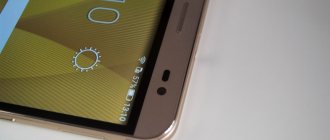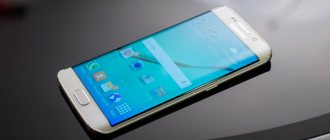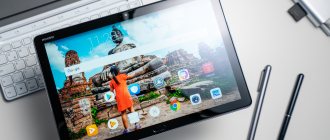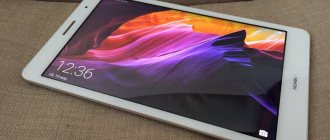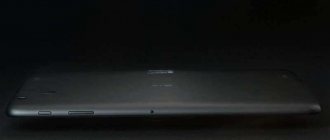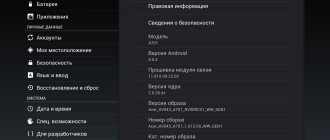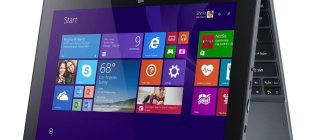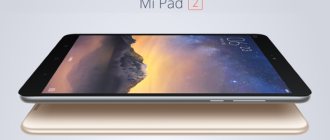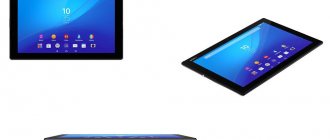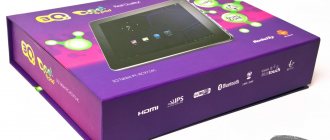09:15 2017-08-29 / Ivan Kushch / Test reviews of equipment
Huawei continues to expand its line of affordable tablets. This time the manufacturer has released a simplified version of its flagship MediaPad M3 models with an 8- and 10-inch screen. We had a tablet with an 8-inch screen at our disposal. Unlike its more expensive counterparts, the new product received a screen with a lower resolution, less RAM, and a less productive chip. At the same time, multimedia functions such as cameras, wireless interface capabilities, and a fingerprint scanner were kept at the flagship level.
The class of tablets with an 8-inch screen has been expanded with a new model from Huawei. The device is called MediaPad M3 Lite 8.0. Among the characteristics of the gadget, it is worth noting the plastic case, small thickness of 7.5 mm, light weight - 310 grams, FullHD screen. In addition, the new product received a separate audio chip and an amplifier for two stereo speakers, the design of which uses proprietary technologies from Harman, one of the leaders in the speaker systems and sound market. I will also note a fingerprint scanner, main and front cameras of 8 megapixels each, 3 GB of RAM, 4G support.
Technical specifications of Huawei MediaPad M3 (model CPN-L09)
| Characteristic | Description |
| Operating system: | Android 7.0 with EMUI 5.1 shell |
| Screen: | IPS-LCD, 8 inches, resolution 1920×1200 (283 ppi), recognition of up to ten simultaneous touches, protective glass with oleophobic coating |
| CPU: | 64-bit 8-core Qualcomm Snapdragon 435 (4-core A53 × 1.4 GHz + 4-core × 1.1 GHz) |
| GPU: | Qualcomm Adreno 505, 450 MHz |
| RAM: | 3 GB |
| Flash memory: | 16 GB / 32 GB |
| SIM card type: | one – nanoSIM |
| Mobile connection: | 2G/ 3G/ 4G |
| Communications: | 802.11 a/b/g/n/ac (2 bands), Bluetooth 4.2, microUSB connector, 3.5 mm audio jack, support 2G/3G/4G (LTE800, LTE1800, LTE2600) |
| Navigation: | GPS, A-GPS, GLONASS, BEIDOU |
| Sensors: | Light sensor, proximity sensor, accelerometer/gyroscope, magnetometer (digital compass), fingerprint scanner |
| Main camera: | 8 megapixels, autofocus, f/2.0, optical stabilization, no flash |
| Front-camera: | 8 megapixels |
| Battery: | non-removable, 4800 mAh |
| Dimensions, weight: | 213.3 x 123.3 x 7.5 mm, 310 g |
| Materials: | Plastic, aluminum |
⇡#Technical characteristics
| Acer Predator 8 | Huawei MediaPad M3 | Huawei MediaPad X2 | Sony Xperia Z3 Tablet Compact | |
| Display | 8 inches, 1920 × 1200 pixels, | 8.4 inches, 2560 × 1600 pixels, | 7 inches, 1920 × 1200 pixels, | 8 inches, 1920 × 1200 pixels, |
| matrix type – IPS | matrix type – IPS | matrix type – IPS + LTPS | matrix type – IPS | |
| Touch screen | Capacitive (10 points), responds to touches with loose gloves | Capacitive (10 points), responds to touches with loose gloves | Capacitive (10 points), responds to touches with loose gloves | Capacitive (10 points), responds to touches with loose gloves |
| Air gap | No | No | No | No |
| Oleophobic coating | Eat | Eat | Eat | Eat |
| Polarizing filter | Eat | Eat | Eat | Eat |
| CPU | Intel Atom X7-Z8700: | HiSilicon Kirin 950: | HiSilicon Kirin 930: | Qualcomm Snapdragon 801 MSM8974AC: |
| four cores of Airmont architecture (x86-64), frequency 2.4 GHz; | four cores ARM Cortex-A72 (ARMv8), frequency 2.3 GHz + | four cores ARM Cortex-A53 (ARMv8), frequency 1.5 GHz + | four Qualcomm Krait-400 cores (ARMv7); | |
| Cherry Trail platform; | four cores ARM Cortex-A53 (ARMv8), frequency 1.8 GHz; | four cores ARM Cortex-A53e (ARMv8), frequency 2 GHz; | frequency 2.5 GHz; | |
| 32-bit and 64-bit computing, | 32-bit and 64-bit computing, ARM big.LITTLE technology (4+4), | 32-bit and 64-bit computing, ARM big.LITTLE technology (4+4), | process technology 28 nm HPm | |
| 14 nm process technology | 16 nm process technology | 28 nm HPC process technology | ||
| Graphics controller | Intel HD Graphics for Atom x5/x7, 600 MHz | ARM Mali-T880MP4, 900 MHz | ARM Mali-T624 MP4, 600 MHz | Qualcomm Adreno 330, 578 MHz |
| RAM | 2 GB LPDDR3 | 4 GB LPDDR4 | 2 GB LPDDR3 | 3 GB LPDDR3 |
| Flash memory | 32 GB + microSD | 32/64 GB + microSD | 16 GB + microSD | 16/32 GB + microSD |
| Connectors | 1 × micro-USB | 1 × micro-USB | 1 × micro-USB | 1 × micro-USB 3.0 |
| 1 × 3.5mm headset jack | 1 × 3.5mm headset jack | 1 × 3.5mm headset jack | 1 × 3.5mm headset jack | |
| 1 × microSD | 1 × microSD | 1 × micro-SIM | 1 × MicroSD | |
| 1 × micro-SIM | 1 × Nano-SIM | 1 × universal slot for nano-SIM or microSD | 1 × Nano-SIM | |
| 1 × magnetic charging connector | ||||
| cellular | No built-in modem | Support for networks of the second, | Support for networks of the second, | Qualcomm MDM9x25 modem (built into SoC): |
| third and fourth generations; | third and fourth generations; | 2G: GSM/GPRS/EDGE 850/900/1800/1900 MHz | ||
| ability to make calls | ability to make calls | 3G: DC-HSPA+ (42.2 Mbps) 850/900/1700/1900/2100 MHz | ||
| 2G: GSM/GPRS/EDGE 850/900/1800/1900 MHz | 2G: GSM/GPRS/EDGE 850/900/1800/1900 MHz | 4G: LTE Cat. 4 (150 Mbps) band 1, 2, 3, 4, 5, 7, 8, 20 | ||
| 3G: DC-HSPA+ (42 Mbps) 850/900/1900/2100 MHz | 3G: DC-HSPA+ (42 Mbps) 850/900/1900/2100 MHz | One Nano-SIM (optional) | ||
| 4G: LTE Cat. 6 (300 Mbps) band 1/3/5/7/8/19/20/28/38/39/40/41 (2100/1800/850/2600/900/800/ 700/1900/2300/ 2500 MHz) | 4G: LTE Cat. 6 (300 Mbps) band 1/3/7/8/28/38/39/40/41 (2100/1800/2600/900/ 700/1900/2300/2500 MHz) | |||
| One SIM card in micro-SIM format + one SIM card in nano-SIM format; | ||||
| work in turns | ||||
| WiFi | 802.11a/b/g/n, 2.4/5 GHz | 802.11a/b/g/n/ac, 2.4/5 GHz | 802.11a/b/g/n, 2.4/5 GHz | 802.11a/b/g/n, 2.4/5 GHz |
| Bluetooth | 4 | 4.1 | 4 | 4 |
| NFC | No | No | No | Eat |
| IR port | No | No | No | No |
| Navigation | GPS, A-GPS, GLONASS | GPS, A-GPS, GLONASS | GPS, A-GPS, GLONASS | GPS, A-GPS, GLONASS, Beidou |
| Sensors | Proximity sensor, | Proximity sensor, | Light sensor, | Accelerometer/gyroscope, digital compass, light sensor, pedometer |
| accelerometer/gyroscope, | accelerometer/gyroscope, | proximity sensor, | ||
| digital compass (magnetometer), pedometer | digital compass (magnetometer), pedometer | accelerometer/gyroscope, | ||
| digital compass (magnetometer), | ||||
| pedometer | ||||
| Fingerprint's scanner | No | Eat | No | No |
| Main camera | 5 MP (2560 × 1920), | 8 MP (3264 × 2448), | 13 MP (4160 × 3120), | 8 MP (3264 × 2448), Sony Exmor RS matrix with back illumination; |
| autofocus, no flash | autofocus, no flash | autofocus, LED flash | autofocus, no flash | |
| Front-camera | 2 MP (1600 × 1200), without autofocus | 8 MP (3264 × 2448), no autofocus | 5 MP (2592 × 1952), no autofocus | 2.2 MP (1920 × 1080), Sony Exmor R matrix with back illumination; without autofocus and flash |
| Nutrition | Non-removable battery | Non-removable battery | Non-removable battery | Non-removable battery |
| Capacity 16.8 Wh (4420 mAh, 3.8 V) | Capacity 19.5 Wh (5100 mAh, 3.8 V) | Capacity 19 Wh (5000 mAh, 3.8 V) | Capacity 17.1 Wh (4500 mAh, 3.8 V); | |
| STAMINA energy saving mode | ||||
| Size | 218 × 127 mm | 215 × 124 mm | 184 × 104 mm | 213 × 123 mm |
| Case thickness 8.6 mm | Case thickness 7.3 mm | Case thickness 7.2 mm | Case thickness 6.4 mm | |
| Dust and water protection | No | No | No | IP65, IP68 (immersion up to 1.5 meters) |
| Weight | 354 g | 310 g | 239 g | 270 g |
| operating system | Google Android 5.0.2 (Lollipop) | Google Android 6.0 (Marshmallow) | Google Android 5.0.2 (Lollipop) | Google Android 4.4.4 (KitKat) |
| Acer proprietary shell | Huawei proprietary shell EMUI 4.1 | Corporate shell EMUI 3.0 | Sony branded shell | |
| Approximate price | Approximately 32,990 rubles | Approximately about 30 thousand rubles | Approximately 24,990 rubles | 20,990 rubles for the 16 GB version |
| 24,990 rubles for the 16 GB + 3G/4G version |
Delivery package and first impressions
The tablet comes in a thick cardboard box. At the top there is an inscription with the name of the model.
In addition to the device itself, the package contains a microUSB cable for synchronization and charging, an electrical adapter, a master key for the SIM card tray, instructions and a warranty card.
As for the tablet itself, it is compact and very thin. I believe that models with an 8-inch screen are the most convenient to use. They make it easy to read text information, websites, and watch movies comfortably. At the same time, the dimensions and weight are not as large as those of devices with a screen of 10 inches or more. The dimensions of Huawei MediaPad M3 Lite are 213.3 x 123.3 x 7.5 mm, weight 310 grams.
The tablet can be grasped with one hand. Of course, you will have to control it with both hands. In general, I did not notice any shortcomings. You can choose a case to protect your tablet. The choice here is more than large.
Advantages and disadvantages of the MediaPad M3 Lite 10 phone
The dimensions of the Huawei MediaPad M3 Lite 10 are 241.3 mm wide, 171.5 mm long and 7.5 mm thick. Men with large hands can easily operate it with one hand, but women with small hands may feel that the device is too big for them. The weight of the device is about 310 grams, this weight is quite noticeable if you hold the phone in one hand; when working with the phone with one hand for a long time, the hand may well get tired.
When looking at the overall ease of use of the phone, there are some issues with it due to the weight or size of the device, but if the other features of the device make up for its shortcomings, then buying this phone is a good choice.
The smartphone is equipped with an 8-core Qualcomm Snapdragon 435 MSM8940 processor, which is made at 28 nm. technical process.
The smartphone has 3 GB. RAM, which is quite enough. In very rare cases it will not be enough, but with this amount of RAM, you will rarely have problems.
The device's data storage capacity is 16 GB, and while this is enough for photos, it may not be enough for video shooting and a large number of games.
The phone is compatible with SD cards, so you can easily expand its memory. So you probably don't need to worry about storage capacity.
The MediaPad M3 Lite 10 has a display diagonal of 10.1 inches. It's quite big. Photos, videos and games will look great on this screen. It is also suitable for productive use, such as creating a business document.
In terms of quality, the screen may appear pixelated when displaying a picture or video. It should be sufficient for normal use.
The main camera of the phone has 7.99 megapixels, which should be enough in most cases. However, you may be slightly unsatisfied with the quality of the photos.
Also, the smartphone has a 7.99 megapixel front camera, which is average for smartphone cameras. This is good enough for taking selfies, but you may not be satisfied with group photos or their print quality.
The battery capacity of Huawei MediaPad M3 Lite 10 is 6660 mAh, which is a very large indicator. Compared to other smartphones, the battery life of the Huawei MediaPad M3 Lite 10 is very long. With such a capacity, you will be pleasantly surprised by the battery life. Even if you watch videos or play games for a long time, you will not have any problems with the battery.
Design and appearance
The design of the Huawei MediaPad M3 Lite has many similarities with the appearance of the Honor line of smartphones. The same finishing materials are used here. The tablet is thin and compact. The body shape is rectangular, aspect ratio is 16:9, the corners are sloping, the edges taper on the sides. An aluminum frame runs along the sides of the tablet, which strengthens the structure and protects it from falls and mechanical damage. There are several plastic inserts along the contour. Antennas for receiving and transmitting data from cellular networks, Wi-Fi, Bluetooth, GPS/GLONASS are located here.
The front panel is covered with glass. There is an oleophobic coating, it is quite effective. The finger glides across the display easily, and any fingerprints that appear are erased quickly.
The back of the case is made of plastic.
The 8-inch MediaPad M3 tablet is available in two colors - silver and bronze (gold). Both colors look very interesting.
Above the screen you can see the 8 megapixel front camera; light and position sensors are also located here. On the right there is a dot LED that starts blinking when messages, emails, etc. arrive.
On the right side you can see the power/lock button and the volume key. The slot for a microSIM-type SIM card, as well as a slot for a microSD memory card, is located below.
On the bottom edge of the tablet there is a microUSB port, as well as a microphone for making calls. The 3.5 mm jack for connecting headphones is located on the top edge.
I will also note two stereo speakers, which are located below and above.
On the back there is a camera without a flash, as well as the “HUAWEI” logo and the inscription “harman/kardon”.
In general, the MediaPad M3 Lite looks very stylish and interesting. There are no questions about the assembly, it is of high quality and reliable.
Design
For some reason, the appearance of the Huawei MediaPad M3 reminded me of just a larger version of the Huawei Mate 9 Pro. Still, the giant has long formed its own principles and aspects of design, which evolve every year. The body of the device is made entirely of aluminum, and the only plastic insert for the antenna output is located on the top rear side, in the same place as the camera eye. By the way, with a very pleasant texture of thin stripes running in a row that are barely noticeable to the eye.
From the photographs you might get the impression that we are reviewing a silver version of the tablet, but this is not the case. In fact, in the review the device is golden in color, but it only looks like that when you look at the back side in low light. In bright light, the back side has a delicate iridescent color between soft gray and soft gold. The so-called “champagne” color, which has become popular in recent years. Also located on the back are the logos of Huawei and Harman/Kardon, with whose help the tablet’s sound capabilities were created.
On the front side there is only a front camera and the company name located on the side. And it’s not at all ugly, like printing an inscription in the center or even below the screen. By the way, the device has very narrow frames, amounting to only 0.5 mm. This is really cool, because, personally, I can safely use the tablet with one hand, without making phantom clicks. Unfortunately, regardless of the color chosen, the front side will remain white. I would prefer the black version on both sides. The tablet has two speakers: one located on top, the other on the bottom. However, when I held the device horizontally in both hands, my fingers never overlapped them. This suggests that the manufacturer was very careful when choosing a location for the speakers. There is also a 3.5mm audio port on the top. At the bottom there is a microphone, an input for Micro USB and a combined tray for Nano SIM and memory card. Working with two SIM cards is impossible. The arrangement of the buttons on the sides is very similar to the “smartphone” version. On the right there is a volume rocker and a power button, on the left there is nothing. For a tablet, a similar arrangement of keys is an excellent solution in terms of ergonomics and ease of use.
Stereo speakers and sound
The MediaPad M3 Lite tablet received an audio system consisting of two stereo speakers. They are located on the upper and lower ends. Huawei states that Harman/Kardon specialists worked to improve the audio system in this model, and a separate AK4396 DAC manufactured by Asahi Kasei Microdevises is responsible for sound reproduction. Dynamic range is 125 dB, distortion is 106 dB.
There is a Smart Power Amplifier and SWS 2.0 surround sound function (best used without a headset).
In portrait orientation of the device, the bottom speaker acts as a subwoofer, and the top one serves to reproduce high frequencies. In landscape orientation, both speakers sound the same, but the stereo is more expanded.
The main advantage of stereo speakers is high volume. The speakers produce a wide range of midrange frequencies without whistling, wheezing or other delights. The volume of sound does not excite the imagination, but it is nobly felt both in music and when watching films. Don't expect a tablet to be able to replace a boombox and amaze its owner with deep bass, because such miracles don't happen in mobile gadgets. However, the device plays many times better than other models even in a higher price category.
Screen. Graphics capabilities
Huawei MediaPad M3 Lite is equipped with an 8-inch screen made using IPS technology without an air gap. The capacitive sensor supports up to 10 simultaneous touches. Resolution - 1920x1200 (283 ppi). Thanks to the aspect ratio, the display is perfect for watching movies, TV series and other videos.
The screen is bright, with vibrant colors. Viewing angles are maximum without purple and yellow tints. The automatic brightness control system, which can also be enabled in the options, worked reliably. But manual control is not the best in practice - the brightness levels are too large.
The tablet has a ClariVu chip, which is responsible for image transmission. There is also “Eye care mode” technology, when the screen turns into warm colors to reduce eye strain.
The picture on the display looks realistic, with high contrast. In complete darkness, the brightness can be reduced to a comfortable value. The mode with automatic brightness adjustment works adequately. There are no questions here.
If we talk about the sensitivity of the screen, it responds quickly to touches and recognizes gestures without problems.
Summing up the results of working with the Huawei MediaPad M3 Lite screen, I can say that it is very decent. There are no obvious shortcomings here.
Why Huawei MediaPad M3 won't work
Because the attempt to offer it as a tablet for audio and video content hides the confusion and existential emptiness of the industry in general. It doesn't offer anything fundamentally new. There is not a single use case for the M3 that would not be possible on a large-diagonal smartphone.
Any Chinese smartphone will offer exactly the same as the Huawei M3 with the exception of the diagonal - in return it will require less space in your pocket. Positioning a tablet as a “better” solution for something that can be done on a smartphone is the most banal and awkward way to stand out from the competition. And almost everyone uses this method today, even Apple can be blamed for a lack of ideas and blindly following trends (eroding the iPad line with incomprehensible and unsuccessful models, for example).
You don't have to look far for examples. Acer gaming tablets failed because carrying a large piece of iron and glass with you specifically for “Asphalt” and “Funny Farm” is absurd, and even a really crazy design couldn’t save the gaming “tablets.” The same skepticism is caused by the proposal to carry a rather large gadget with you for watching movies or listening to music. The paradigm of using tablets that dominates the market today - and this is still the consumption of content - implies a much less intensive use of gadgets, a longer life cycle than in the case of smartphones. This is one of the reasons for the rapid saturation of the market: having bought even a non-top device three or four years ago, the owner continues to use it successfully. A well-designed Android tablet from three years ago still successfully plays movies, and games, even if they reduce detail due to an insufficiently powerful processor, are at a disadvantage in advance, because No one expects incredible “pictures” from mobile projects.
Of course, all this does not mean that Huawei M3 will not be bought. Its audience is travelers, fans of dialer + tablet combinations, and gadget lovers. People who have empirically come to the conclusion that what they really need is a quality mobile tablet, not an all-in-one phablet. The only point is that people will buy it in the same way as tablets from other brands, that is, not very good.
Hardware platform: processor, memory, performance
MediaPad M3 Lite is equipped with a 64-bit Qualcomm Snapdragon 435 chip with an octa-core processor: 4 Cortex A53 cores with a clock speed of up to 1.4 GHz + 4 Cortex A53 cores with a maximum frequency of 1.1 GHz. Graphics subsystem (GPU) – Adreno 505 450 MHz. There is 3 GB of RAM. Tablets with 16 and 32 GB flash memory are available for sale. You can expand the built-in memory using microSD cards. The device has a corresponding slot for this.
If we talk about the operation of the interface, then in most work scenarios I did not notice any glitches or slowdowns. The picture and transitions are smooth, launching applications is fast. Browser, video - here sometimes there are slowdowns and slowness. All this is related to the speed of the hardware used.
In 3DMark, the tablet scored about 9,900 and 600 points in the Ice Storm Unlimited and Fire Strike scenarios, in AnTuTu 5 and 6 – 39,000 and 46,000 points. The CPU cores are also not very encouraging. In the Geekbench 3 and 4 tests, the MediaPad M3 Lite could not even score 700 points in single-threaded performance; in the multi-threaded test, we get 3,200 and 2,900 points. The GFXBench result in the Manhattan Offscreen and T-Rex Offscreen runs was only about 8 and 17 fps, so it’s unlikely that you’ll be able to play comfortably on the MediaPad M3 Lite.
Domino
There are various rumors around Huawei chips; user reviews vary dramatically - from delight to indignation. We will limit ourselves to the facts: the Chinese took it upon themselves to create high-performance ARM architecture chips and, on the whole, coped with the task. The undivided hegemony of the American Qualcomm was broken. Now in the consumer market for ARM solutions, in addition to the Americans, Huawei, Samsung and MediaTek are present. Note, however, that the first two companies use their chips exclusively in their own gadgets (MediaTek does not produce smartphones).
The first generation of Huawei mobile processors was criticized for not having the best energy efficiency and high heat dissipation relative to Qualcomm, which, accordingly, affected the operating time. However, having worked on the mistakes, in November 2015 the Chinese announced the Kirin 950 and positioned it as a flagship solution. The chip has eight cores, its direct competitors are Samsung Exynos 8 Octa 8890 and Qualcomm Snapdragon 821.
True, it is impossible to call the processor eight-core in the sense in which this characteristic is applied to desktop CPUs; the chip has four more powerful Cortex-A72 cores with a frequency of up to 2.53 GHz, and four more economical Cortex-A53 with a frequency of up to 1.8 GHz.
This decision had a beneficial effect both in games and on operating time. In terms of performance, of course, there are already more powerful solutions, but it’s still unlikely that any game project can fully load the Kirin 950. The number of frames drops only in graphics benchmarks. The processor is well supported by 4 GB of RAM - the M3 instantly switches from “heavy” tasks to everyday applications, be it an office, a browser or an audio player. Of course, there were also controversial issues that relate to the operating system: during testing, there were more than once cases when, after switching to the desktop, a resource-intensive program continued to run in the background and consume battery power.
By the way, the operating time, if the gadget is not “raped” with games all night long, is quite decent - up to one and a half to two days. Here, of course, we must take into account that the actual survivability will greatly depend on whether the tablet has a SIM card, whether you like to download torrents over the cellular network, etc., etc. Let’s say right away that our day of work was done without a cellular module, but with periodic races in the heavy toy Asphalt 8: Airborne.
Huawei MediaPad M3 is an ideal tablet for consuming multimedia content and everyday tasks. But there is one problem.
Communication capabilities
The tablet supports all modern communication networks: 2G/3G and 4G on Russian frequencies. The quality of signal reception is not satisfactory; the device confidently maintains communication indoors and does not lose the signal in areas of poor reception.
The device supports telephone calls over a mobile network. To do this, it is more convenient to connect a headset and talk through it.
MediaPad M3 Lite can work with all modern wireless networks. Among them are dual-band Wi-Fi 802.11 ac/b/g/n, Wi-Fi Direct, you can organize a wireless access point via Wi-Fi or Bluetooth channels. All modules work quickly and without failures.
Among the additional communication tools, it is worth noting GPS, A-GPS, GLONASS, BeiDou (standard Google Maps cartography is built into the smartphone). The navigation error radius during testing was about 10 meters, which is very little. The gadget copes well with the role of a navigator.
A fingerprint scanner is built into the central button below the screen. During my experiments, it recognized the fingerprint very well. The sensor can be used instead of Android's on-screen buttons, but it's not as convenient as we'd like. The sensor is not supported in third-party applications, unless you can hide/display the notification shade and scroll through pictures in the gallery.
Duration of work
The tablet has a lithium-ion battery with a capacity of 7800 mAh. The tablet's battery life is good, but not outstanding. The battery capacity is average, and as a result, the results are average. In continuous reading mode, the device worked for 14.5 hours, in video viewing mode – about 7 hours. This is already a good result, although not a record one.
With an average usage scenario (the Internet is turned on, browsing the Internet 3 hours a day, watching a movie for 2 hours a day, playing games for up to 30 minutes a day), the tablet worked for two days. These indicators are typical for many mid-level devices.
User Interface and Operating System
MediaPad M3 Lite runs the original Android 7.0 operating system with Huawei's proprietary shell installed - EMUI 5.1.
All programs are displayed in one list on the main and adjacent screens.
In the settings of the MediaPad M3 Lite there is an option for eye protection (it is turned on only during reading - the amount of blue color decreases, that is, the picture becomes warmer).
Among the pre-installed programs, it is worth noting Office from Microsoft, social network clients, file manager, FM radio.
Any other programs on the tablet can be installed from the Google Play store.
How to be
It is unknown what could shift interest in tablets among potential consumers to the volumes that characterize smartphones. And this is not the first year that the smartphone market has experienced a shortage of a good driver for demand. The industry has already survived Sony’s attempts to increase demand for “tablets” with water resistance and the ability to control a BRAVIA TV; the Samsung Note line (not to be confused with phablets), which offered the ability not only to consume, but also to create content, suffered the same fiasco. Consumers have seen everything in the last 5 years, even giant kitchen tablets (Panasonic, Apple) and tablets squashed to the size of a coffee table (Microsoft).
Oddly enough, the easiest way to increase tablet sales may be to abandon Android. Its versatility and prevalence have played a cruel joke on gadgets: even the most inexpensive device running it, starting with version 5.0 with Google Play installed, has 90% of the capabilities of the most expensive one with any diagonal and on any processor. There are, of course, more complex ways - a more thoughtful differentiation in the Android ecosystem for services and content designed specifically for a large screen, but they don’t exist yet.
If the industry abandons Android in favor of a more specific system, we will automatically get unique use cases, the same user experience that smartphones will no longer be able to compete with. The only thing that will suffer is the user experience. But the industry is no stranger to such sacrifices.
What about Huawei MediaPad M3? Empirically, we found out two main facts about him. This is definitely a tablet, and a good one at that. But now this is not enough.
Camera. Photo and video capabilities
Huawei MediaPad M3 Lite is equipped with two cameras. The main one is 8 megapixels, f/2.0, with autofocus. There is no flash. The camera is typical average. Outdoors, in good lighting, it takes high-quality pictures with a minimum of noise. But in difficult lighting, in rooms with difficult light, the photos turn out to be unrealistic.
The main camera of the smartphone can record video with sound in the maximum FullHD resolution. The quality of the video can be rated as “C”. In good lighting, the videos look bright, without changes in light. Video looks a little blurry in low lighting conditions
I will also mention the front camera for selfies. It's 8 megapixels. The pictures come out very high quality.
The design of the camera app is similar to other Huawei products. Flicking to the right reveals available modes such as Panorama, HDR or Time Lapse. Swiping left provides access to options. The main interface looks neat, although some icons are too small for the large display.
Results
The main conclusion that can be drawn based on the results of two weeks of testing is that the Huawei MediaPad M3 Lite 8.0 tablet is a kind of compromise between functionality and price. The manufacturer tried to offer an inexpensive tablet with maximum functions. And for the most part, he succeeded. Firstly, I was pleased with the high-quality 8-inch screen. The picture quality here is not bad, although it is inferior to the same MediaPad M3 8.0 in terms of resolution. Secondly, the device is compact and looks very impressive. Thirdly, the tablet produces high-quality and surround sound stereo sound. This is a definite plus for fans of watching movies and video clips. Fourthly, the presence of LTE support. This means that the tablet can be used outside of Wi-Fi.
The MediaPad M3 Lite 8.0 also has some disadvantages. Firstly, this is very average hardware in terms of performance. For basic tasks it will, of course, be sufficient. But when loading heavy promotional sites on the Internet, games with serious graphics, the interface will slow down. Also worth noting are the cameras. Both the main one and the front one – both take average quality pictures in good lighting. In difficult conditions, photos and videos are excellent. In addition, the tablet cannot boast of maximum autonomy.
To sum it up, the price of 17,000 rubles for the 16 GB version looks a little higher than one would expect. MediaPad M3 Lite 8.0 has a lot of competitors among the Chinese in the form of devices from Xiaomi, Lenovo, etc.
Advantages
High quality build
Good screen
Quality speakers
LTE support
Flaws
The front and main cameras take average quality pictures and videos
Not all programs and applications are adapted for horizontal screen orientation
What is Huawei MediaPad M3?
Huawei M3 is an excellent example of a modern tablet that has all the external signs of a successful device, but which, for all that, needs a new paradigm, the idea of the “tablet” itself.
The gadget is based on a high-performance chip of its own design, Kirin 950, with a considerable amount of memory on board - from 32 to 64 GB, plus support for microSD cards up to 256 GB. The tablet can work with LTE, screen resolution is qHD, matrix type is IPS. Top-end characteristics are supported by an attractive external design: excellent aluminum body, chamfers, fit of parts - exactly at the level that you expect from a tablet for about 27 thousand rubles (version with a memory capacity of 32 GB).
The device is very convenient to use, perhaps 8 inches diagonal - exactly the form factor that allows you to watch movies and read books with greater convenience than on phablets, at the same time, such a gadget is easy to carry with you. If the diagonal were an inch smaller, marketers would have more work: try to explain to a typical Euroset visitor why he should buy a slightly larger tablet in addition to a 5-inch smartphone. Still, 8” visually makes the M3 stand out.
But even taking into account that the gadget is perceived precisely as a tablet, it is not enough to enter the market simply with a set of good characteristics. Huawei also took this into account: the key feature of the M3 compared to competitors from other manufacturers is that the tablet is focused primarily on audio and video content.


